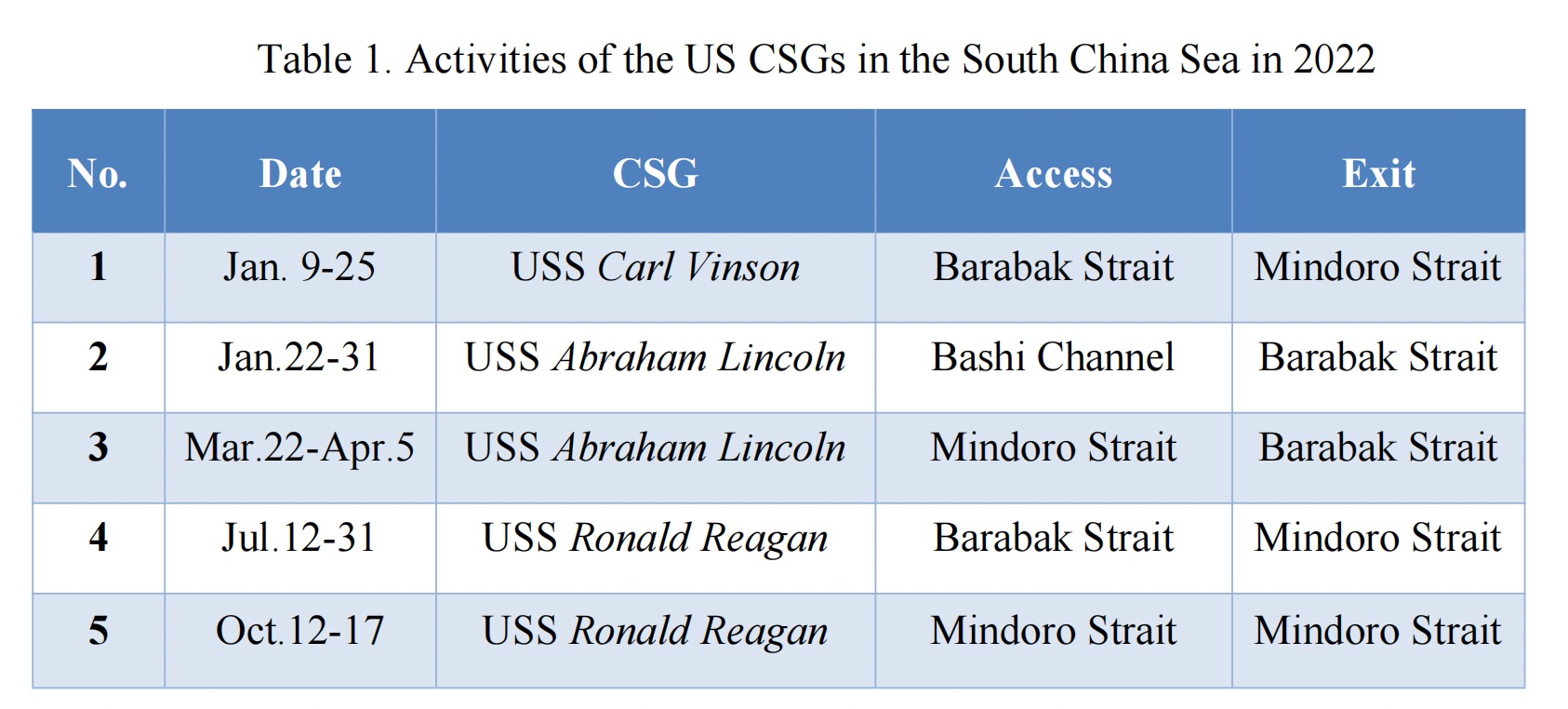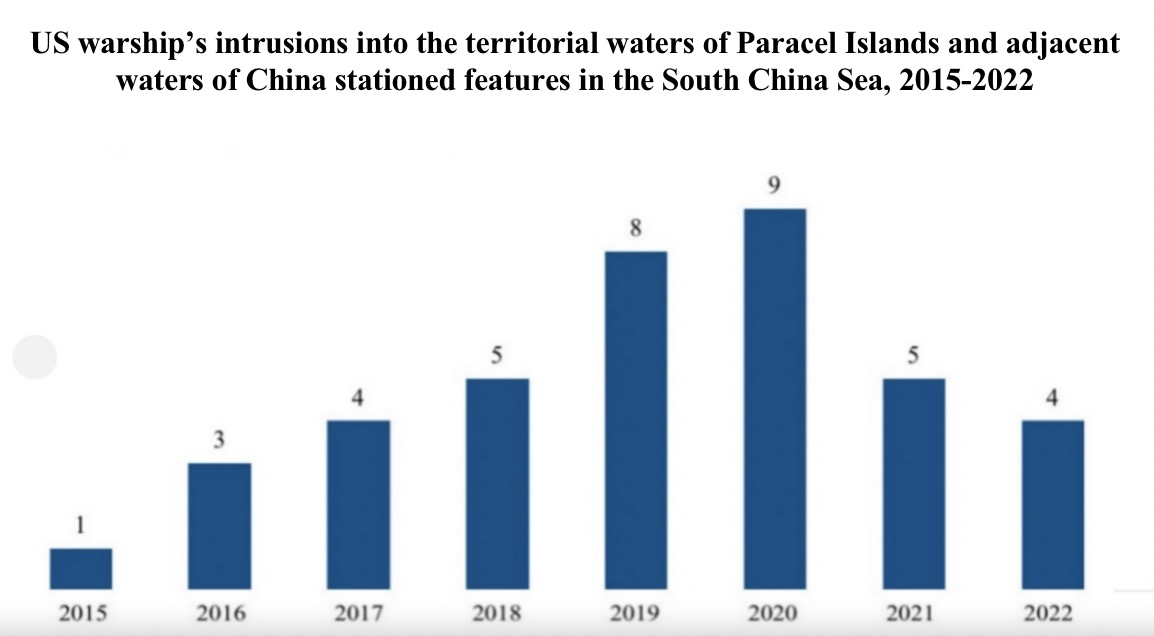Perface
In peacetime, conducting highly-intensified military activities in a coastal state’s surrounding waters, such as thousands of close-in reconnaissance operations and hundreds of military exercises, is contrary to the spirit of “maintaining international peace and security” of the UN Charter and "the peaceful uses of the seas" of the United Nations Convention on the Law of the Sea (UNCLOS).
Since 2009, US military activities against China in the South China Sea have strengthened in frequency and intensity. Against the backdrop of the Russia-Ukraine conflict, US military operations in the South China Sea continued unabated in 2022, significantly increasing the risk of maritime and air frictions and conflicts between China and the US. Are China’s warships and aircraft too close to the US’s, or conversely the US warships and aircraft get too close to China? Here lies the main divergence between China and the US in maritime crisis management.
In 2022, the politicization of military operations by the US military has been further enhanced, with increased exposure to the Taiwan Strait transit operations, deployment of carrier strike groups (CSGs), military exercises and drills. The Pentagon and the US military have also repeatedly highlighted the so-called “dangerous interception” or “unprofessional” actions of the PLA at sea to put diplomatic, public and strategic pressure on China.
However, excessive deterrence and stimulations will provoke more determined countermeasures from China, and contribute to destabilizing action-reaction cycles. At present, deterrence and counter-deterrence, stimulation and counter-stimulation, as well as provocation and counter-provocation have become critical strategic and tactical issues in US-China maritime interaction.
The US military’s presence and operations in the South China Sea are major factors affecting the situation in the South China Sea. Since 2019, the South China Sea Strategic Situation Probing Initiative (SCSPI) has been releasing the annual report, An Incomplete Report on US Military Activities in the South China Sea. The report is intended to promote the transparency of South China Sea Situations and provide the perspective of a third-party think tank for reference to government departments, research institutions, media and the public of related parties.
Director of SCSPI Hu Bo 
Key Findings
During 2022, the US military deployed 3 carrier strike groups (CSGs), 2 amphibious ready groups (ARGs), 20 bombers, and 12 nuclear attack submarines (SSNs) in the South China Sea and its surrounding areas, carrying out frequent targeted patrols and drills to strengthen military deterrence against China.
-
In 2022, 3 CSGs and 2 ARGs transited through the South China Sea, 5 times and 3 times respectively. Except for USS Ronald Reagan’s 20-day deployment in the South China Sea during July, the other CSGs stayed for about 10 days at most, much longer than an average 4-5 days in 2021. The access route taken by the CSGs was always San Bernardino Strait, Mindoro Strait, Barabak Strait, Verde Island Channel and other straits within the Philippine Archipelago. Only USS Abraham Lincoln passed through Bashi Channel to enter the South China Sea, in early 2022.
-
The US military has been pushing the ‘Lighting Carrier’ concept in recent years to strengthen its power presence. In the Western Pacific, the trend of the US Navy is to promote “1+1” --which means to deploy 1 CSG+1 ARG simultaneously.
-
As to underwater forces, the US military deployed at least 12 SSNs in the Western Pacific.
-
In addition, the US Air Force flew 20 sorties of B-52H or B-1B bombers in 11 batches in and out of the Western Pacific Area. Of these, at least 5 sorties of bombers entered the South China Sea.
In 2022, the US military continued sending reconnaissance aircraft and ships to conduct high-intensity reconnaissance operations in the South China Sea. In the air, the US conducted around 1,000 large reconnaissance aircraft sorties over the South China Sea, which was slightly lower than in 2021. However, the sorties of electronic reconnaissance aircraft increased. At sea, the US military, including ocean surveillance ships and oceanographic survey ships, have conducted regular operations in the South China Sea, totaling 339 ship-days.
-
In 2022, the US sent about 1,000 sorties of large reconnaissance aircraft of various types into the South China Sea from Osan Base in the ROK, Kadena Base in Okinawa, Anderson Base in Guam, and Clark Base in the Philippines, reaching the Chinese mainland’s territorial air space on several occasions.
-
The high-altitude airship/sounding balloon project was part of a Multi-Domain Sensing System concept, which has been under development by the US Army and Marine Corps. It would fill the gap between ground-based, air-based and space-based Intelligence, Surveillance, and Reconnaissance systems. At least 4 high-altitude airships were deployed during the US-Philippines Exercise Balikatan 2022.
-
In 2022, the US military successively deployed 4 ocean surveillance ships in the South China Sea. They spent a total of 134 ship-days operating in the South China Sea. Another 3 oceanographic survey vessels were deployed for seabed topography and geomorphology as well as the marine meteorological and hydrological survey. These 3 survey vessels spent 205 ship-days in the South China Sea.
Since 2020, the frequency of the US military's “island-intrusive” FONOPs in the South China Sea has decreased; from 9 in 2020 and 8 in 2021 to 4 in 2022. However the tendency of politicizing FONOPs and conjuncture with major US agenda towards China is more obvious.
In 2022, the US military has continued to carry out operations in the Taiwan Strait. The number of US warships transiting the Taiwan Strait was 9 in total. Although the frequency has decreased significantly compared with 12 in 2021, the public hype and political manipulation beyond the physical actions taken greatly increased. US P-8A anti-submarine patrol aircraft flew over the Taiwan Strait 3 times, the same number as in 2021. Combined with US legislators and other politicians’ frequent visits to Taiwan, the US military has made targeted deployments to strengthen the deterrence around the Taiwan Strait against China. The coordination among the different operations carried out in the Taiwan Strait, the South and the East China Sea is clearly strengthening.
According to incomplete statistics, in 2022, the US military carried out 102 large-scale exercises, together with thousands of small and medium-scale drills in the South China Sea and surrounding areas. Both the frequency and scale increased compared to 2021. Taking China as an imaginary enemy, US military exercises subjects included anti-submarine, air defense, mine, and amphibious operations as well as verification actions for new operational concepts.




Content
I. Increasingly targeted strategic platforms’ activities
II. Intensively carried out close-in maritime and aerial reconnaissance
III. The island-intrusive FONOPs
IV. Improving the coordination of operations between the Taiwan Strait, the South and the East China Sea
V. Strengthen combat readiness through exercises and drills
Ⅵ. Summary and prospect
Appendix
Please download PDF for full report.

